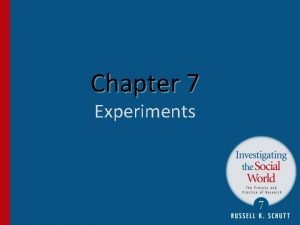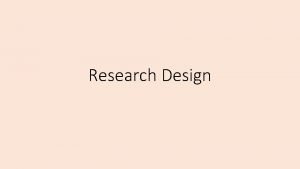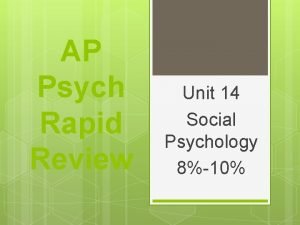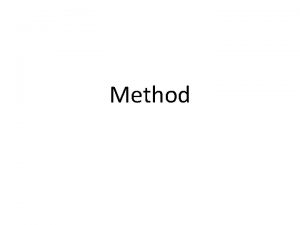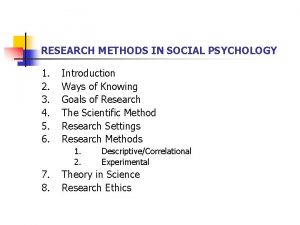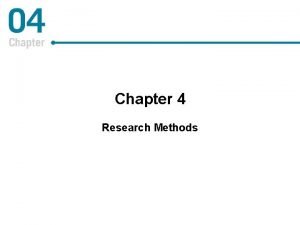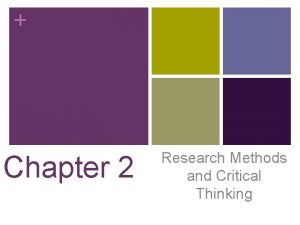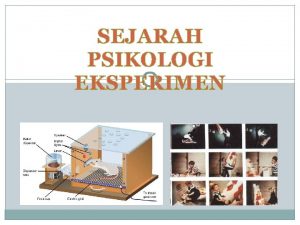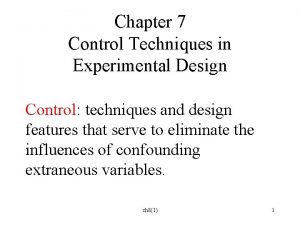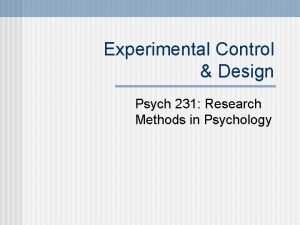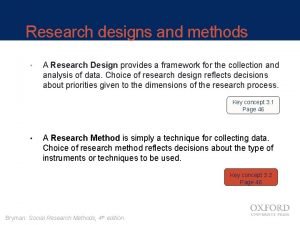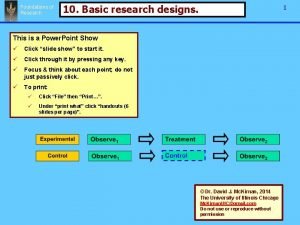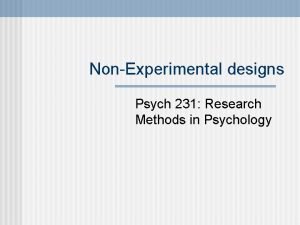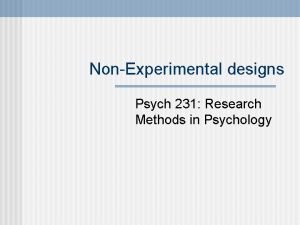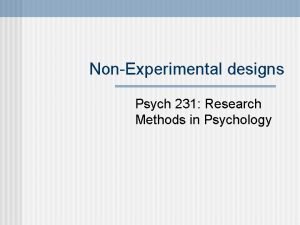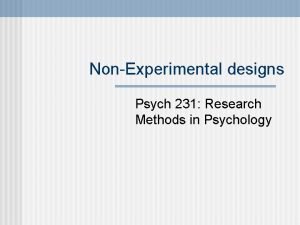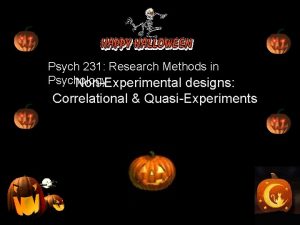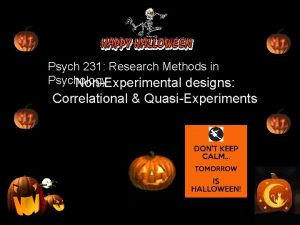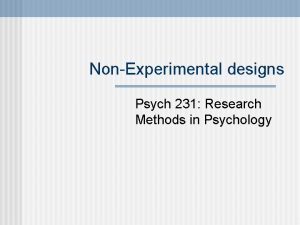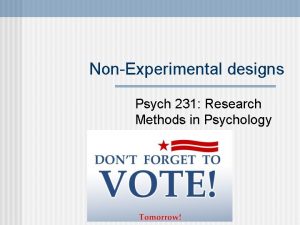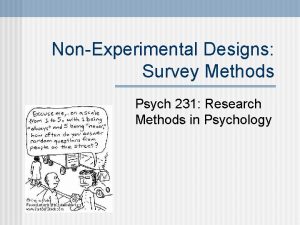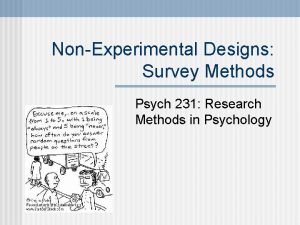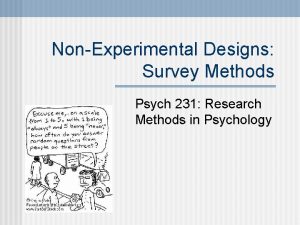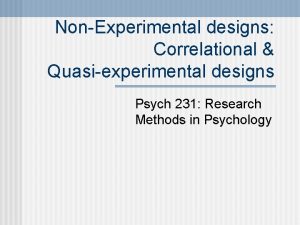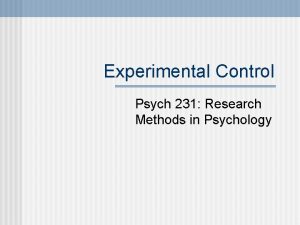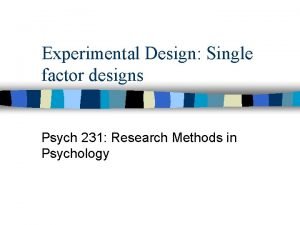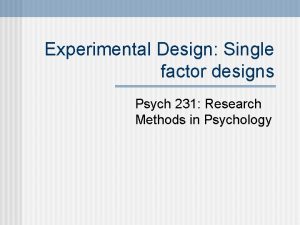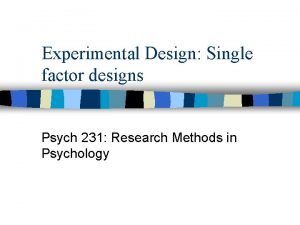Experimental Designs Psych 231 Research Methods in Psychology





























- Slides: 29

Experimental Designs Psych 231: Research Methods in Psychology

n Exam 2 coming up: Monday Oct 27 th n n Review session Thursday 6: 30 De. Garmo 463 Piloting experiments in lab this week Announcements

n 1 Factor - two levels n n n Advantages: • Simple, relatively easy to interpret the results, good first step, sometimes all you need Disadvantages: • “True” shape of the function is hard to see 1 Factor - more than two levels n Advantages • Better picture of the function • Less worry about your range of the independent variable n Disadvantages • Needs more resources (participants and/or stimuli) • Requires more complex statistical analysis (analysis of variance and pair-wise comparisons) Experimental Designs

n Factorial Designs: Two or more factors n Advantages • Interaction effects • Adding factors decreases the variability • Because you’re controlling more of the variables that influence the dependent variable • This increases the statistical Power of the statistical tests • Increases generalizability of the results • Because you have a situation closer to the real world (where all sorts of variables are interacting) n Disadvantages • Experiments become very large, and can become unwieldy • The statistical analyses get much more complex • Interpretation of the results can get hard • Need more resources Factorial experiments

n What is the effect of presenting words in color on memory for those words? n So you present lists of words for recall either in color or in black-and-white. Clock Chair Cab n Clock Chair Cab Two different designs to examine this question Example

n Between-Groups Factor § 2 -levels § Each of the participants is in only one level of the IV levels Colored words Clock Chair Cab participants Test BW words Clock Chair Cab

n Within-Groups Factor § Sometimes called “repeated measures” design § 2 -levels, All of the participants are in both levels of the IV levels participants Colored words Clock Chair Cab Test BW words Clock Chair Cab Test

n Between-subjects designs n Each participant participates in one and only one condition of the experiment. n Within-subjects designs n All participants participate in all of the conditions of the experiment. Colored words Test participants BW words participants Colored words Test BW words Test Between vs. Within Subjects Designs

n Between-subjects designs n Each participant participates in one and only one condition of the experiment. n Within-subjects designs n All participants participate in all of the conditions of the experiment. Colored words Test participants BW words participants Colored words Test BW words Test Between vs. Within Subjects Designs

n Clock Colored words Chair Cab Advantages: Test participants BW Clock words Chair Cab n Independence of groups (levels of the IV) • Harder to guess what the experiment is about without experiencing the other levels of IV • Exposure to different levels of the independent variable(s) cannot “contaminate” the dependent variable • Sometimes this is a ‘must, ’ because you can’t reverse the effects of prior exposure to other levels of the IV • No order effects to worry about • Counterbalancing is not required Between subjects designs

n Disadvantages Clock Colored words Chair Cab Test participants BW Clock words Chair Cab n Individual differences between the people in the groups • Excessive variability • Non-Equivalent groups Between subjects designs

n The groups are composed of different individuals participants Colored words BW words Individual differences Test

n The groups are composed of different individuals participants n Colored words BW words Excessive variability due to individual differences n Test Harder to detect the effect of the IV if there is one Individual differences NR R R

n The groups are composed of different individuals participants n Colored words Test BW words Non-Equivalent groups (possible confound) n The groups may differ not only because of the IV, but also because the groups are composed of different individuals Individual differences

n Strive for Equivalent groups n n n Created equally - use the same process to create both groups Treated equally - keep the experience as similar as possible for the two groups Composed of equivalent individuals • Random assignment to groups - eliminate bias • Matching groups - match each individuals in one group to an individual in the other group on relevant characteristics Dealing with Individual Differences

Group A Red Short 21 yrs Blue tall 23 yrs Green average 22 yrs Brown tall 22 yrs Group B matched Matching groups Red Short 21 yrs Blue tall 23 yrs Green average 22 yrs Brown tall 22 yrs n Matched groups n n Trying to create equivalent groups Also trying to reduce some of the overall variability • Eliminating variability from the variables that you matched people on Color Height Age

n Between-subjects designs n Each participant participates in one and only one condition of the experiment. n Within-subjects designs n All participants participate in all of the conditions of the experiment. Colored words Test participants Colored words Test BW words Between vs. Within Subjects Designs

n Advantages: n Don’t have to worry about individual differences • Same people in all the conditions • Variability between conditions is smaller (statistical advantage) n Fewer participants are required Within subjects designs

n Disadvantages n Order effects: • Carry-over effects • Progressive error Counterbalancing is probably necessary to address these order effects Within subjects designs

n Carry-over effects n n Transfer between conditions is possible Effects may persist from one condition into another • e. g. Alcohol vs no alcohol experiment on the effects on hand-eye coordination. Hard to know how long the effects of alcohol may persist. Condition 1 Condition 2 test Order effects How long do we wait for the effects to wear off? test

n Progressive error n n Practice effects – improvement due to repeated practice Fatigue effects – performance deteriorates as participants get bored, tired, distracted Order effects

n Counterbalancing is probably necessary n This is used to control for “order effects” • Ideally, use every possible order • n! (e. g. , AB = 2! = 2 orders; ABC = 3! = 6 orders, ABCD = 4! = 24 orders, etc ). n All counterbalancing assumes Symmetrical Transfer • The assumption that AB and BA have reverse effects and thus cancel out in a counterbalanced design Dealing with order effects

n Simple case n n Two conditions A & B Two counterbalanced orders: • AB • BA Colored words Test BW words Test Colored words Test participants n Not so simple analysis: need to analyze as a factorial design, with 2 factors (word color & order) Counterbalancing

n n Simple case More than two conditions: n Often it is not practical to use every possible ordering • n! (e. g. , AB = 2! = 2 orders; ABC = 3! = 6 orders, ABCD = 4! = 24 orders, etc ) • Common Solution: Partial counterbalancing • Latin square designs – a form of partial counterbalancing, so that each group of trials occur in each position an equal number of times Counterbalancing

n Example: consider four conditions Recall: ABCD = 4! = 24 possible orders 1) Unbalanced Latin square: each condition appears in each position (4 orders) n Order 1 A B C D Order 2 B C D A Order 3 C D A B Order 4 D A B C Partial counterbalancing

n Example: consider four conditions Recall: ABCD = 4! = 24 possible orders 2) Balanced Latin square: each condition appears before and after all others (8 orders) n A B C D A B D C B C D A B C A D C D A B C D B A D A B C D A C B Partial counterbalancing

n Mixed designs n n Treat some factors as within-subjects (participants get all levels of that factor) and others as between-subjects (each level of this factor gets a different group of participants). This only works with factorial (multi-factor) designs Mixed factorial designs

Source Word Type Depth of Proc Word * Depth Error (within) Error (btwn) SS 22. 4 120. 3 10. 5 357. 1 456. 4 df 1 148 148 Mean Square 22. 4 120. 3 10. 5 2. 4 3. 1 F 9. 3 39. 0 4. 3 Sig. . 003 <. 001. 039 • Main effect of both variables • An interaction Class experiment results

n You need to describe: n n n How many factors How many levels of each factor Whether the factors are within or between groups • e. g. , 2 (shallow/deep processing) x 2 (abstract/concrete) mixed groups factorial design abstract concrete Shallow 4. 0 4. 2 Deep 4. 9 5. 8 Describing your design
 Quasi-experimental research designs
Quasi-experimental research designs Quasi-experimental research designs
Quasi-experimental research designs Disadvantages of experimental research
Disadvantages of experimental research Proposal penelitian eksperimen psikologi
Proposal penelitian eksperimen psikologi Experimental design principles
Experimental design principles Matched pairs design
Matched pairs design Informal experimental designs
Informal experimental designs Basic principles of experimental designs
Basic principles of experimental designs Classical conditioning
Classical conditioning Social loafing ap psychology definition
Social loafing ap psychology definition Research paradigm example
Research paradigm example Research instrument in experimental research
Research instrument in experimental research Experimental vs non experimental
Experimental vs non experimental What are the 5 types of non experimental research design
What are the 5 types of non experimental research design Experimental vs nonexperimental research
Experimental vs nonexperimental research Nonexperimental study
Nonexperimental study Research methods in social psychology
Research methods in social psychology Research methods in developmental psychology
Research methods in developmental psychology Research methods in abnormal psychology
Research methods in abnormal psychology Ocr psychology research methods
Ocr psychology research methods Chapter 2 critical thinking answers
Chapter 2 critical thinking answers Tokoh psikologi eksperimen
Tokoh psikologi eksperimen Correlational research psychology
Correlational research psychology Experimental method in psychology
Experimental method in psychology Alla chavarga
Alla chavarga Incomplete counterbalancing
Incomplete counterbalancing Experimental design psychology
Experimental design psychology Findings of qualitative research
Findings of qualitative research Types of research
Types of research Basic research designs
Basic research designs

